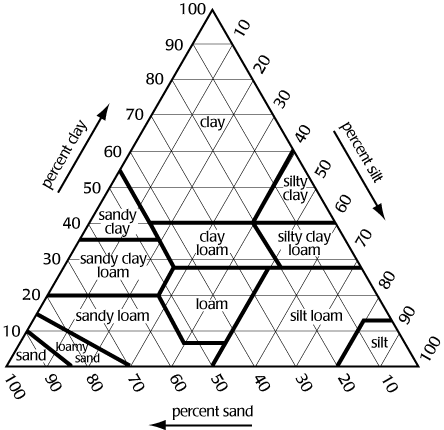Soil is a crucial part of any garden, and achieving a teeming microbial ecosystem and a robust humus layer are vital components to a garden’s success.Do you want a bountiful garden bursting with ripe produce? Well, a soil with just the right amounts of silt, sand, clay, and humus will get you there. This optimal soil type is called loam. The percentage of silt, sand, and clay in loam soil is roughly 40% silt, 40% sand, and 20% clay (as depicted by the soil texture triangle below). This article provides applicable techniques to help gardeners achieve and/or maintain loam soil no matter what their soil type currently is.

Source: Soil Texture Triangle: “Analytical Research Laboratory.”
Secondary Micronutrients, https://nutrients.ifas.ufl.edu/nutrient_pages/BSFpages/SoilTriangle.htm.
Step 1: Make sure the soil has enough organic matter.
There are several simple ways to make sure soil has enough organic matter, which creates humus. First, do not remove dead leaves that fall on the soil. Whether they blow off your neighbors tree and land in your garden, or whether your own plants are starting to brown and lose their leaves, by keeping these on the soil you are allowing room for the natural process of decay to occur and for a humus layer to build up. Second, when you trim your plants, purposefully place the cut parts on top of your soil (rip any large pieces into smaller ones) so their nutrients can cycle back into the garden! Third, add compost to the soil. This can be homemade or store bought compost. Lightly turn it into the topsoil around your plants. Do this each time you plant new crops, and eventually the whole bed will have a good amount of compost. At Yardener, we always recommend purchasing the most sustainably and locally made compost available. Your crops and environment will thank you!
Step 2: Leave it be.
It is important to leave the soil as undisturbed as possible. This helps retain soil moisture, and helps your garden bed act as a carbon sink. Consider the fact that every time soil is turned, some of the carbon it contains is released back into the atmosphere. So instead of turning or tilling your soil to aerate it, try using an aeration fork. This doesn’t need to be done very often. This effectively aerates the soil, without completely messing with its existing structure.
Step 3: Keep it moist.
Most of these suggested steps increase soil moisture. This is a key part in building loam soil. Some practices that increase soil moisture are keeping the soil covered constantly (expanded on in Step 4), maintaining a good layer of humus (as discussed in Step 1), and watering your garden in the early morning or in the evening. By watering in the early morning or around sunset, the water is absorbed more efficiently as less is evaporated by the sun.
Step 4: Avoid leaving the soil uncovered.
Try to keep every inch of your soil covered at all times. When soil is left exposed for too long, it dries up and its nutrients are depleted. Consider planting some perennials, cover crops, and using close-space planting techniques. If you ever have a bare area in your garden, use a tarp to cover the soil until you are ready to plant.
Step 5: Welcome the birds and critters.
This one is tough sometimes. Pesky rodents that feast on your vegetables when you are asleep can be extremely frustrating. However, try to respect these natural occurrences and let them take place. Think about what happens when birds land in your garden. Their feet gently turn the topsoil (which delicately aerates the soil), they eat harmful insects (keeping their populations in check and making room for the beneficial ones to move in), and they leave behind nutrients in their excrements which become soil. There is a time and a place to thoughtfully discourage animal activity in your garden, but the majority of the time these creatures are not causing harm and are, in fact, making your garden soil richer. All of the steps mentioned above work together to improve soil quality, ultimately creating loam soil for plants to thrive in. Additionally, these steps reduce the amount of labor your garden requires, so you can enjoy happier plants
while allowing natural processes to do most of the work for you.

